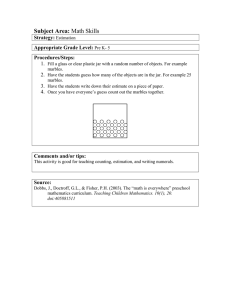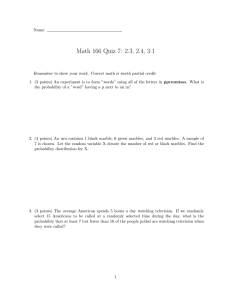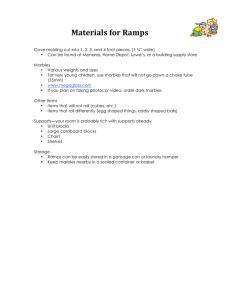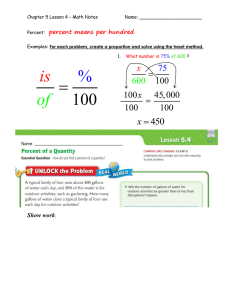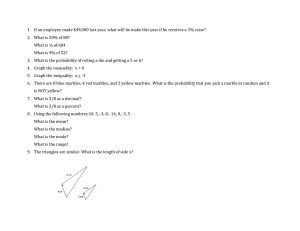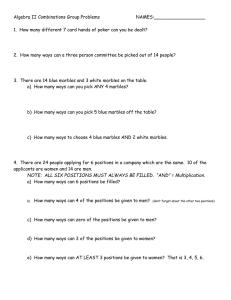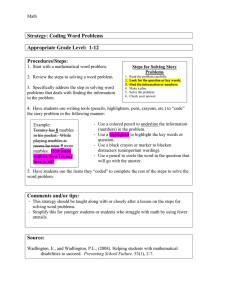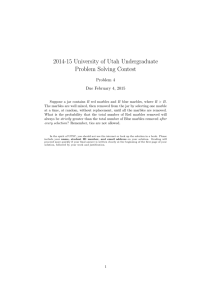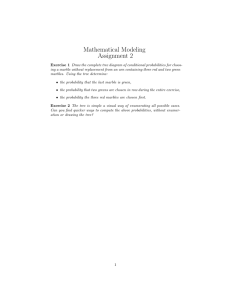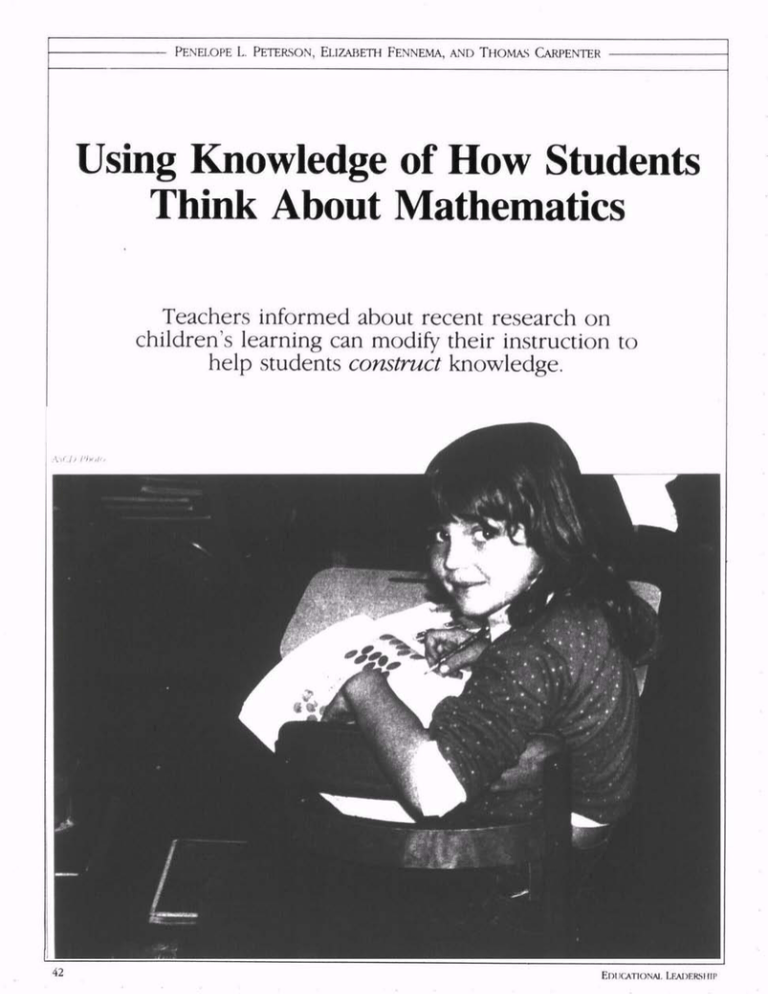
PENELOPE L. PETERSON, ELIZABETH FENNEMA, AND THOMAS CARPENTER
Using Knowledge of How Students
Think About Mathematics
Teachers informed about recent research on
children's learning can modify their instruction to
help students construct knowledge.
EDUCATIONAL LEADERSHIP
A
common metaphor is that the et al. 1988, Fennema et al. in press). The
mind of the learner is like a teachers then used this knowledge in
tower of building blocks: the their own ways to modify their teaching
foundation must be built before of addition and subtraction. We turn
higher blocks can be added. Accord now to the research findings that we
ingly (fortified by task analysis and shared with the teachers.
behaviorism), mast teaching in ele
mentary school has rested on the as Children's Informal
sumption that students must learn Knowledge of Mathematics
lower-order facts and skills before When young children first begin to
they are able to master higher-order solve addition and subtraction word
problem-solving and application skills. problems, they can only create a di
Recent theory and research from cog rect, concrete representation of the
nitive psychology, however, suggest that problem (Carpenter and Moser 1983,
knowledge is stored in the learner's Riley et al. 1983). They typically use
head as a network of concepts or con their fingers, physical objects, or
structs: the mind of the learner is like a counters to represent each quantity in
construction of tinker toys. Learning is the problem, and represent only the
the making of connections between specific action or relationship de
new information and the learner's exist scribed in the problem. For example,
ing network of knowledge—the con suppose we gave a kindergartner the
struction of knowledge by the learner— following problem: "Melissa has three
and instruction should facilitate these cookies. How many more does she
connections.
need to have six cookies all together?"
In a network theory of cognition To solve this problem, the child might
and learning, the concepts of lower- use counters (or spools, buttons, or
and higher-order learning rarely make rocks) to make a set of three objects,
sense For example, computational add more objects until she had a total
skills do not exist as lower-order pre of six, and then count the number of
requisites for higher-order mathemat objects she had added to the original
ical problem solving, but rather are set.
Through interviewing children and
learned in relation to and as part of
problem solving (see, for example, studying how they talk about prob
Resnick 1985) Both "top-down" and lems, researchers have found that chil
"bottom-up" processes occur in learn dren's problem-solving strategies be
come increasingly abstract as they are
ing mathematics
If we are to foster the formation of
these cognitive networks, new infor
mation must be related in a meaning
ful way to information that the learner
already knows. Problem solving and
meaningful learning are based on Computational
knowledge: people "continually try to
understand and think about the new in skills do not exist
terms of what they already know" as lower-order
(Glaser 1984, p 100) Moreover, the
specific content knowledge one al prerequisites for
ready possesses plays a central role in higher-order
one's thinking and learning.
New research on cognition and in mathematical
struction can be used profitably to problem solving, but
"formulate the principles that can rather are learned in
guide interventions designed to help
people learn" (Resnick 1985, p 180) relation to and as
To help teachers apply this research in part of problem
the classroom, we gave 1st grade teach
ers access to recent findings on chil solving.
dren's mathematics learning (Carpenter
DECEMBER 1988/lANUARY 1989
able to engage in more abstract think
ing. Children then begin to use more
advanced counting strategies like
"counting on" or "counting back " For
example, to solve the cookie problem
above, the child might use a "counting
on" strategy if she recognized that it
was not necessary to construct the first
set of three objects. The child might
simply count on from three to six,
keeping track of the number of counts
either on her fingers or with objects.
Children's Invented
Mathematics Strategies
Eventually children memorize num
ber facts that help them solve word
problems Children learn number
facts over an extended period of time
rather than all at once (Carpenter and
Moser 1983). Also, they leam some
number facts earlier than others, such
as doubles like 5 + 5 = 10. Most
important, until they have memorized
all the addition facts, many children
naturally employ a small set of mem
orized facts to derive solutions for
problems that have various number
combinations. The following illus
trates children's use of derived facts to
solve a word problem:
Teacher. "Six frogs were sitting on lily
pads Eight more frogs joined them. How
many frogs are there then?"
Rudy. Denise, Theo, and Sandra
each answer "14" almost immediately.
Teacher-. "How do vou know there are
14?"
Rudy "Because 6 and 6 is 12. and 2
more is 14."
Denise "Eight and 8 is 16. But this is 8
and 6 That is 2 less, so it's 14."
Theo "Well. I took 1 from the 8 and gave
it14"
to the 6 That made 7 and 7. and that's
Sandra: "Eight and 2 is 10. and 4 more is
14"
Most children—not just the gifted—
derive new facts from the facts they
have already learned. Even without
explicit instruction, children discover
these strategies; and even with instruc
tion that emphasizes symbol manipu
lation, children continue to rely di
rectly on these strategies to represent
problems and on counting techniques
to solve them.
43
Problem Type
A. Connie had 5 marbles.
Jim gave her 8 more marbles.
How many does Connie have
all together? (result unknown)
B. Connie has 5 marbles.
How many more marbles does
she need to win to have
13 marbles all together? (change
unknown)
C. Connie had some marbles.
Jim gave her 5 more marbles.
Now she has 13 marbles. How
many marbles did Connie have
to start with? (start unknown)
A. Connie had 13 marbles. She
gave 5 marbles to Jim How
many marbles does she have left?
(result unknown)
B. Connie had 13 marbles. She
gave some to |im. Now she has 5
marbles. How many did Connie
give to Jim? (change unknown)
C. Connie had some marbles.
She gave 5 to |im. Now she
has 8 marbles left. How many
marbles did Connie have
to start with? (start unknown)
III. Part-Part-Whole
A. Connie has 5 red marbles and 8
blue marbles. How many marbles
does she have?
. Connie has 13 marbles. Five are
red and the rest are blue. How
many blue marbles does Connie
have?
IV. Compare
A. Connie has 13 marbles. Jim has
5 marbles. How many more
marbles does Connie have
than Jim?
I. loin
II. Separate
B. Jim has 5 marbles. Connie
has 8 more than Jim. How
many marbles does Connie have?
C. Connie has 13 marbles. She has
5 more marbles than |im. How
many marbles does Jim have?
Fig. 1. Classification of Word Problems
Children's Knowledge of
Word Problems
In the eyes of children, not all addition
or subtraction problems are alike.
Children perceive important distinc
tions among different types of addition
problems and among different types of
subtraction problems. One way of
classifying problems corresponds to
the way children themselves think
about problems. This classification
scheme distinguishes problems that
children solve in different ways and
provides a framework to identify' the
relative difficulty of different problems
(fig. 1).
In this model, there are four basic
categories of addition and subtrac
tion problems: Join, Separate, PartPan-Whole, and Compare. Join and
Separate problems involve action In
Join problems, elements are added to
a given set. In Separate problems,
elements are removed from a given
set. Part-Pan-Whole problems involve
comparisons between two disjoint
sets. Within each of these categories
are several distinct types of problems
that differ according to which quan
tity is the unknown: the initial quan
tity (start unknown), the second
quantity (change unknown), or the
final quantity (result unknown). Text
books often include only Join Result
Unknown and Separate Result Un
known problems, thus limiting chil
dren's ability to apply their mathe
matics skills to solve problems.
44
Principles for Classroom
Instruction
From our reading of the research on
1st graders' learning and cognition in
mathematics, we derived several prin
ciples for instruction:
• Rather than introducing story
problems to children after they have
mastered computational skills, teach
ers should use problem solving as
the basis for teaching addition and
subtraction.
• Teachers need to be familiar with
a broad array of word problems and to
know the processes that children usu
ally use to solve different problems.
• Teachers can assess not only
whether a child can solve a particular
problem but also how the child solves
the problem. Teachers need to analyze
children's thinking by asking appro
priate questions and by listening to
children s responses.
• Teachers need to use the knowl
edge they derive from assessment and
diagnosis of children to design appro
priate instruction. Teachers should or
ganize instruction so that children can
easily and actively construct their own
knowledge.
• Teachers should ensure that their
mathematics instruction stresses rela
tionships among concepts, skills, and
problem solving.
We defined an instructional ap
proach based on these principles
called "Cognitively Guided Instruc
tion" (CGI).
Teachers' Knowledge of
Student Cognitions
We hypothesized that it might be im
portanl for teachers to know the men
tal processes, or cognitions, by which
learners acquire specific subject mat
ter knowledge in mathematics There
fore, we investigated whether teachers
knew the cognitions that 1st graders
use to solve addition and subtraction
problems We wanted to answer these
questions: (a) What do teachers know
about distinctions that children natu
rally make between story problems in
addition and subtraction:' and (b)
What do teachers know about the cog
nitions and strategies that children typ
ically use to solve different addition
and subtraction word problems-'
In our study, we measured the
knowledge of 40 1st grade teachers
through questionnaires and interviews
(Carpenter et al. in press). We found
that most of the 1st grade teachers
were able to identify the critical dis
tinctions between addition and sub
traction word problems (fig. 1). and
the kinds of strategies that children
use to solve such problems However,
the teachers had not organized their
knowledge into a coherent network
relating the different types of word
problems to their difficulty and to chil
dren's cognitions for solving them.
An Experimental Study
To determine whether providing teach
ers access to recent research on chilEDUCATIONS LEADERSHIP
drens mathematics learning would
cause them to modify their instruction,
we conducted a controlled experiment
Forty 1st grade teachers agreed to par
ticipate (the same teachers whose
knowledge we had surveyed). Half were
assigned randomly to an experimental
or CGI group, and half to a control
group Control teachers participated in a
half-day workshop on problem solving.
CGI teachers participated in a four-week
summer workshop during which we
presented recent findings on children's
learning and cognition in addition and
subtraction. We did not train the partic
ipants in either workshop in specific
techniques for classroom instruction.
Following the workshops, these
four assumptions elicited more agree
ment from CGI teachers than from
control teachers:
1 Children construct their own
mathematical knowledge
2. Mathematics instruction should
be organized to facilitate children's
construction of knowledge
3 Children's development of mathe
matical ideas should provide the basis
for sequencing topics for instruction
4 Mathematical skills should be
taught in relation to understanding
and problem solving.
We found that, as a result of the
workshops, the knowledge base of
CGI teachers was enhanced; and they
subsequently changed their classrixim
instruction.
Effects on teachers'
classroom instruction
A CGI Teacher in Action
The following illustrates how one CGI teacher encouraged the use of multiple
strategies to solve word problems that had practical meaning for students.
During the first few minutes of the day, Ms. White asked how many children
wanted hot lunches that day. Eighteen children raised their hands. Six children were
going to eat cold lunches. Ms. White asked, "How many children are going to eat
lunch here today?"
By starting with 18 and counting on, several children got to the answer of 24. One
child got out counters and counted out a set of 18 and another set of 6. He then
counted all of them and said "24."
Ms. White then asked, "How many more children are eating hot lunch than are
eating cold lunch?"
Several children counted back from 18 to 12. The child with the blocks matched
18 blocks with 6 blocks and counted the blocks left over.
Ms. White asked the children who volunteered to tell the rest of the class how they
got the answer. Ms. White continued asking for different solutions until no one could
think of a new way to solve the problem.
Children perceive
important
distinctions among
different types of
addition problems
and among different
types of subtraction
problems.
more often concerned computations
and number facts
The workshops ux>k place in June Effects on students'
1986 During the 1986-8^ schixil year, problem-solving and
we observed the teachers and their computational skills
students for four one-week periods, In September and again in May, stu
the first in October and the last in dents in the CGI and control teachers'
April Both systematic observations classes completed the Iowa Test of
and anecdotal evidence revealed dif Basic Skills (ITBS) and an experiment
ferences between CGI and control er-constructed word-problem solving
teachers in their teaching of addition test Regression analyses on students'
and subtraction CGI teachers posed post-test scores, adjusting for pretest
problems more often, and more often achievement scores, showed that stu
expected students to use multiple dents in CGI teachers' classes had sig
strategies rather than a single strategy nificantly greater ability to solve addi
to solve a problem They often began tion and subtraction word problems,
the lesson by telling a story and then particularly complex word problems
posed word problems based on the Further, a significant aptitude-treat
storv. Control teachers interactions ment interaction (ATI) with prior
DF.CRMHFR 198H/jANi*Ry 1989
achievement showed that lower
achieving CGI classes especially bene
hted from the CGI approach, as shown
by their achievement on a test of sim
ple word problems In addition, stu
dents in CGI classes were more confi
dent of their ability to solve word
problems than were students in con
trol teachers classes Finally, although
the observation data indicated that
control teachers spent more rime on
addition and subtraction number facts
than did CGI teachers, the students in
CGI teachers classes did as well as
students in control teachers classes on
a computation test, and CGI students
actually had better recall of number
facts
Extending Teachers'
Knowledge Base
We draw three important conclusions
from our study. First, a substantive
knowledge base now exists regarding
the psychology of children's class
room learning of mathematics Sec
ond, even experienced teachers do
not have this knowledge Third, if
teachers are given access to this
knowledge, they can enhance their
understanding of children's classroom
learning in mathematics and improve
their classroom instruction
These experiences demonstrate that
knowledge of the psychology of chil
dren's learning and cognition is useful
to teachers. The challenge is to make
this research-based knowledge acces
sible to both practicing teachers and
students in teacher education pro
grams. If we do so, perhaps all teach
ers will be able to help their students
actively construct knowledge. D
References
Carpenter, T.P., and J.M. Moser. (1983).
"The Acquisition of Addition and Sub
traction Concepts." In The Acquisition of
Mathematics Concepts and Processes,
edited by R. Lesh and M. Landau. New
York: Academic Press.
Carpenter, T.P., E. Fennema, P.L. Peterson,
C.'Chiang, and M. Loef. (April 1988).
"Effects of Cognitively-Guided Instruc
tion on Students' Problem Solving." Pa
per presented at the 1988 annual meet
ing of the American Educational
Research Association, New Orleans.
Carpenter, T.P., E. Fennema, P.L. Peterson,
and D Carey (In press). "Teachers' Ped
agogical Content Knowledge in Mathe
matics. Journal for Research in Mathe
matics Education
Fennema, E., T.P. Carpenter, and P.L Peterson (In press). "Learning Mathematics
with Understanding." In Advances in
Research on Teaching, vol. 1, edited byj
Brophy Greenwich, Conn: JAI Press, Inc
Glaser, R. (1984) "Education and Think
ing: The Role of Knowledge." American
Psychologist 39: 93-104
Resnick, LB (1985). "Cognition and lastruction: Recent Theories of Human Compe
tence" In Master Lecture Series: Volume4,
Psychology and Learning, edited by B.L
Hammonds Washington, D.C: American
Psychological Association.
Riley, M.S., JG Greeno, and Heller, J.I.
(1983) "Development of Children's
Problem-Solving Ability in Arithmetic "
In The Development of Mathematical
Thinking, edited by H Ginsburg New
York: Academic Press.
Autbors' Note: The research reported in
this paper was supported in part by a grant
from the National Science Foundation
(Grant No. MDR-8550236) The opinions
expressed in this paper do not necessarily
reflect the position, policy, or endorse
ment of the National Science Foundation
For further information on the workshop
and staff development materials described
in this article, write to Elizabeth Fennema
at the address below
Penelope L. Peterson is Co-Director,
Institute for Research on Teaching, 510
Erickson Hall, Michigan State University,
East Lansing, MI 48824-1034 Elizabeth
Fennema and Thomas Carpenter are
Professors of Curriculum and Instruction,
National Center for Research in Mathemat
ical Sciences Education, Wisconsin Center
for Education Research, University of Wi
sconsin-Madison, 1025 W Johnson St., Ma
dison, WI 53706.
COOPERATIVE
TAUGHT.........not caught
Dr. Carol Cummlngs.
This exciting video, featuring
is filled with both practical ideas and many
elementary classroom clips highlighting:
why cooperative team learning Is Important
what classroom routines need to be taught
social skills necessary for success
how to create Interdependence
Format:
1/2" VMS
PLUS one complete lesson with a master teacher demon
strating how to set up a cooperative lesson for a creativewriting assignment, with emphasis on giving specific 'put-ups'
and listening skills
INTRODUCTORY PRICE: $119.00
Lanaitueo minutes
PO Box 788
Send to: Teaching, Inc.
I COOPERATIVE LEARNING
I
Name _
Address
46
Edmonds WA 98020
I
$119.00
City
(206)774-0755
I Preview/ 3 days
$3000
State/Zip
EDUCATIONAL LEADERSHIP
Copyright © 1988 by the Association for Supervision and Curriculum
Development. All rights reserved.

